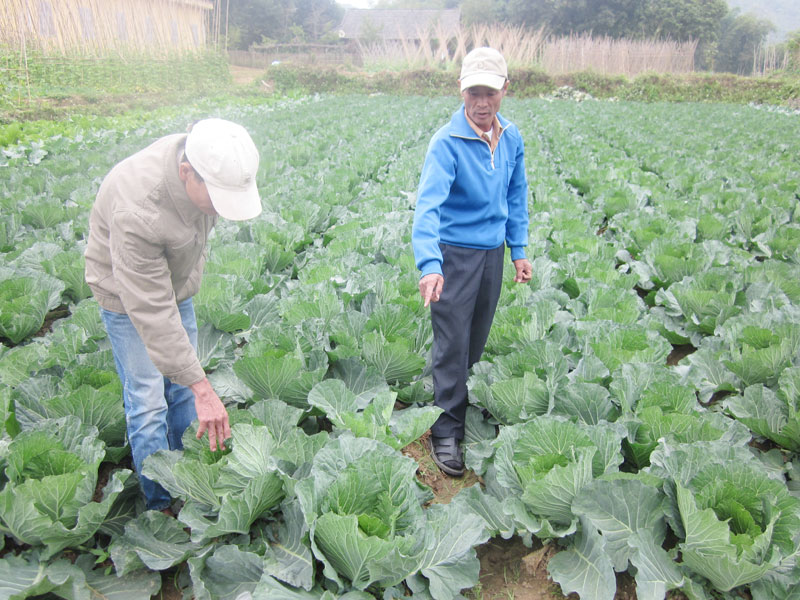
(HBO) - Noong Luong commune was the first area being selected by Mai Chau district to experiment with the model of cabbage growing in the direction of food safety and consumption linkage.

the households in Noong Luong commune (Mai
Chau) grow cabbage in the off-seasonal crop brings higher economic efficiency
than some other kinds of vegetables.
The pilot model is financially supported by
the production support program of the Board of Ethnic Minority and Agricultural
– Forestry Encouragement Station, which is the implementing unit.
Participating in the model, Mr. Ngo Van
Phuong in Pieng Dau village has planted 500 cabbages. Mr. Phuong said that with
other families, his family already did farming and planting since March.
Before, the farmers cultivated many kinds of vegetables, such as lettuces,
peanuts and maize, but since they changed to plant off- seasonal cabbages, they
have gained more income. Some households plant 300-500 cabbages such as Mr. Ha
Van Dat’s households in Pieng Dau village, Ms. Ngan Thi Hoan in Noong Luong
village.
It is known that, to implement linking the
planting and consumption tasks of off seasonal cabbages in the off-seasoned
crop, more than 70 households in Noong Luong and Pieng Dau villages have signed
a contract with the enterprises for output guarantees, such as Tam Hoa
Cooperative (Tan Son commune - Mai Chau) and Luong Phu Cooperative (Tan Lac)
with the number of 32 thousand cabbages. In the implementation process, the
participating households are trained and guided about technology. The
fertilizer resource is microbiological fertilizer compost used in safe farming.
Through the conclusion, the whole crop has 26,000 cabbages, equivalent to over
80% of the total number of cabbages for harvest. Especially, with the linkage
model, products made by farmers were purchased totally at a price of 4,500 VND
/ kg, which made the average income of 185 million VND / hectare. After
excluding the cost of production including seed, fertilizer, each hectare of
planting cabbages brought the interest of about 120 million VND.
Mr. Vi Van Dang, the Head of the Agricultural
– Forestry Encouragement Station of Mai Chau district said that the model can
be planted in 2 crops / year, from March to June and from July to September
every year. Through the initial efficiency of the model, the farmers'
perceptions of crop restructure, the value added per unit of cultivated area
were raised. This is also one of the models that help to promote and enhance
the value chain where the objective of crop restructuring is progressing.
According to data from the Hoa Binh Provincial Party Committee, the industrial production index for the first six months of 2025 is estimated to have increased by 20% compared to the same period last year. This marks the highest year-on-year growth rate for this period since 2020.
In the first six months of 2025, Hoa Binh province’s export turnover was estimated at 1.145 billion USD, marking an 18.11% increase compared to the same period in 2024. Import turnover was estimated at $ 804 million, a 17.15% increase, which helped the province maintain a positive trade balance.
The lives of the ethnic minority farmers in Tan Lac district have gradually improved thanks to the new directions in agricultural production. This is a testament to the collective strength fostered through the professional associations and groups implemented by various levels of the district’s Farmers’ Union.
With the motto the "product quality comes first,” after nearly one year of establishment and operation, Muong village’s Clean Food Agricultural and Commercial Cooperative, located in Cau Hamlet, Hung Son Commune (Kim Boi district), has launched reputable, high-quality agricultural products to the market that are well-received by consumers. The products such as Muong village’s pork sausage, salt-cured chicken, and salt-cured pork hocks have gradually carved out a place in the market and they are on the path to obtaining the OCOP certification.
In the past, the phrase "bumper harvest, rock-bottom prices" was a familiar refrain for Vietnamese farmers engaged in fragmented, small-scale agriculture. But today, a new spirit is emerging across rural areas of Hoa Binh province - one of collaboration, organisation, and collective economic models that provide a stable foundation for production.
Maintaining growing area codes and packing facility codes in accordance with regulations is a mandatory requirement for agricultural products to be eligible for export. Recently, the Department of Agriculture and Environment of Hoa Binh province has intensified technical supervision of designated farming areas and packing facilities to safeguard the "green passport" that enables its products to access international markets.



